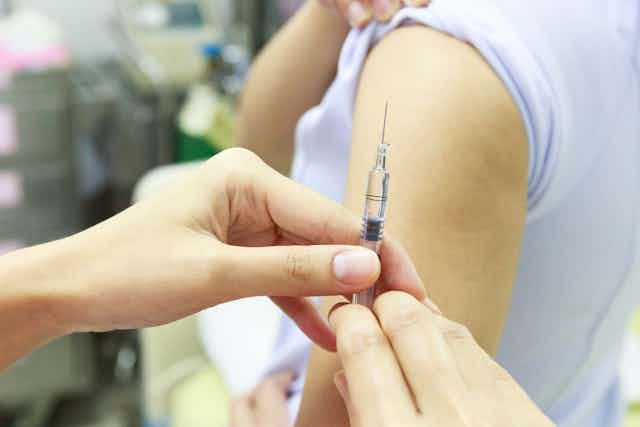Millions of children in England risk contracting potentially fatal diseases as vaccination rates continue to fall for the second year running. According to Gillian Leng, deputy chief executive of the UK’s National Institute for Health and Care Excellence, about 3m children and adolescents may have missed their mumps, measles and rubella (MMR) vaccine.
It is not possible to vaccinate every child in the country. At any given time, some children will be too young and a very small number will have allergies or other conditions that make vaccination unacceptably risky. However, if a sufficient proportion of the population are vaccinated, a disease cannot spread and everyone is protected. This is known as “herd immunity”. The World Health Organisation (WHO) considers that a 95% uptake is necessary to achieve this protection.
Low vaccination rates are a particularly English problem: Scotland, Wales and Northern Ireland all achieve the WHO target, although there are pockets, particularly in economically deprived urban areas, where they fall short. In England, the national rates are 2-3% below WHO recommended levels. In some urban areas, particularly those with high levels of deprivation and minority ethnic populations, rates fall towards 80%. This creates a high risk of outbreaks of serious childhood diseases.
Reasons for the fall in uptake
The decline in vaccination rates is often attributed to parental resistance provoked in the late 1990s by the now-discredited claim made by Andrew Wakefield of a link between the MMR vaccine and autism. However, the comparisons between the different nations within the UK suggest a more complex picture.

Before we blame parents, we should consider whether they have easy access to child health advice and vaccination services. If they are not aware of the benefits and cannot get to the places where vaccines are available, we should not be surprised if their children are not vaccinated.
Although the UK has a single framework of principles and funding for the NHS, each component nation chooses how to organise their delivery. Scotland, Wales and Northern Ireland have had less reorganisation than England so they have been able to focus on providing rather than reforming their services.
An improvement in vaccination rates in England coincided with the rebuilding of the health visiting service under the 2010-15 UK coalition government. Health visitors are specialist nurses who provide screening, counselling, advice and support to all families with children from birth to the age of five. Health visitor numbers increased by 49% and the average caseload for each health visitor fell from just over 400 to around 280 children. Staffing shortages remained in the urban areas where low vaccination rates are found.
However, much of this investment has since been negated by local authority cuts since they took over responsibility for the service in October 2015. The improvement in vaccination rates seems to have come to a halt or reversed slightly in the last two years. This is a time when there have been increasing cutbacks in Sure Start children’s centres – their numbers and budgets are down by about a quarter since 2010 – and problems in sustaining GP vaccination clinics among the other pressures on primary care.
The lack of support for reaching out to parents contributes to the low uptake. Traveller groups, for example, have difficulty accessing healthcare. Some minorities have distinctive medical traditions. These beliefs are often dismissed as irrational or primitive by health professionals – a poor foundation for persuading parents of the benefits of change. Recent migrants may simply not understand how the health system works and what is available to them.
All these problems are familiar to health visitors, whose interpersonal skills can make an impact, provided that caseloads allow enough time to engage parents.
Overt resistance is much less common. There are a small number of “new age” parents, whose preferences for alternative medicine could probably be accommodated without compromising herd immunity.
Of more concern is the emerging group of affluent parents who are opting out because they believe they can micromanage all risks to their children. This group has not been studied in the UK, but recent work in California found that where there is a critical mass of parents who think this way in a school catchment, refusal rates are high because the parents believe that the minimal risks from vaccination need not be accepted. They can insulate their children from the “others” who carry infectious disease. Their children do not share school classrooms, public transport or public leisure facilities with children from poorer backgrounds. Their children’s social contacts are carefully supervised so that they only mix with other children from a similar background whose parents think in the same way. They seem to be the forerunners of the “helicopter parents” who hover over their children at university and even into first employment.
We may need to relearn the lessons that drove public health reform in 19th-century Britain: infectious diseases are a potential threat to everyone. No one can buy protection on an individual basis.

